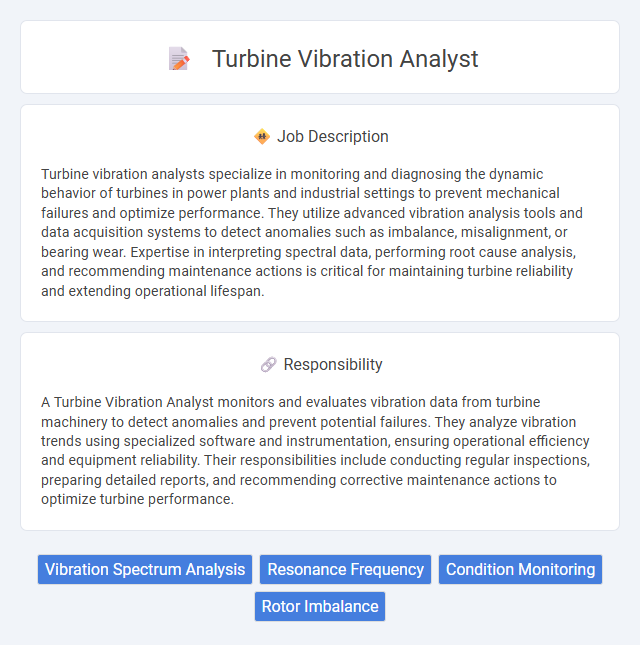
Turbine vibration analysts specialize in monitoring and diagnosing the dynamic behavior of turbines in power plants and industrial settings to prevent mechanical failures and optimize performance. They utilize advanced vibration analysis tools and data acquisition systems to detect anomalies such as imbalance, misalignment, or bearing wear. Expertise in interpreting spectral data, performing root cause analysis, and recommending maintenance actions is critical for maintaining turbine reliability and extending operational lifespan.
Individuals with a strong analytical mindset and attention to detail are likely to be well-suited for a turbine vibration analyst position, as the role demands precise monitoring and interpretation of complex data patterns. Candidates who possess a solid understanding of mechanical systems and vibration analysis techniques may find themselves better equipped to diagnose issues promptly and recommend effective maintenance solutions. Those with good problem-solving skills and the ability to work under pressure might have a higher probability of thriving in the fast-paced environment typical of this job.
Qualification
Turbine vibration analysts require a strong background in mechanical or electrical engineering, often holding a bachelor's degree in these fields. Expertise in vibration monitoring equipment, data analysis software, and interpretation of vibration spectra is essential for diagnosing turbine issues. Proficiency in standards such as ISO 10816 and experience with predictive maintenance techniques significantly enhance job performance and reliability in turbine operation.
Responsibility
A Turbine Vibration Analyst monitors and evaluates vibration data from turbine machinery to detect anomalies and prevent potential failures. They analyze vibration trends using specialized software and instrumentation, ensuring operational efficiency and equipment reliability. Their responsibilities include conducting regular inspections, preparing detailed reports, and recommending corrective maintenance actions to optimize turbine performance.
Benefit
Turbine vibration analysts likely benefit from enhanced job security due to the critical role they play in maintaining turbine efficiency and preventing costly breakdowns. Their expertise probably leads to opportunities for career advancement within industries such as power generation and aerospace. They may also enjoy competitive salaries and specialized training that strengthens their technical skills and marketability.
Challenge
Turbine vibration analyst roles likely present significant challenges related to accurately diagnosing complex vibration patterns to prevent equipment failure. The job probably demands continuous adaptation to evolving diagnostic technologies and in-depth knowledge of mechanical systems. Analysts may frequently confront high-pressure situations requiring precise data interpretation to ensure turbine reliability and safety.
Career Advancement
Turbine vibration analysts leverage advanced diagnostic tools and vibration analysis techniques to monitor and maintain turbine performance, ensuring operational efficiency and reliability. Mastery in predictive maintenance and root cause analysis opens pathways to senior technical roles, such as lead analyst or maintenance engineering manager. Continuous skill enhancement in data interpretation, condition monitoring, and industry-standard software drives career advancement and higher earning potential in the energy sector.
Key Terms
Vibration Spectrum Analysis
Turbine vibration analysts specialize in Vibration Spectrum Analysis to detect mechanical faults within turbine components by interpreting frequency patterns and amplitude variations. They utilize advanced diagnostic tools to monitor vibrations in real-time, identifying issues such as imbalance, misalignment, or bearing defects to prevent costly downtime. Expertise in data acquisition, signal processing, and fault diagnosis ensures optimal turbine performance and prolongs equipment lifespan.
Resonance Frequency
A Turbine Vibration Analyst specializes in monitoring and analyzing vibration data to detect resonance frequency issues that can lead to catastrophic turbine failures. Accurate identification of resonance frequencies is crucial for diagnosing potential fatigue and structural weaknesses in turbine components. Advanced diagnostic tools and modal analysis techniques are employed to mitigate resonance effects and ensure operational reliability.
Condition Monitoring
Turbine vibration analysts specialize in condition monitoring to detect early signs of mechanical faults and prevent turbine failures. They use advanced vibration analysis techniques and tools such as accelerometers and spectrum analyzers to assess turbine health and ensure operational efficiency. Expertise in interpreting vibration data enables precise diagnostics, reducing downtime and maintenance costs in power plants and industrial facilities.
Rotor Imbalance
A Turbine Vibration Analyst specializing in Rotor Imbalance monitors and evaluates vibrations caused by uneven mass distribution in turbine rotors, using advanced diagnostic tools like vibration sensors and spectral analysis software. Precise identification of rotor imbalance is crucial to prevent excessive wear, reduce downtime, and ensure optimal turbine performance. Expertise in balancing techniques, real-time vibration monitoring, and fault diagnosis significantly enhances machinery reliability and extends the lifecycle of turbine components.
 kuljobs.com
kuljobs.com